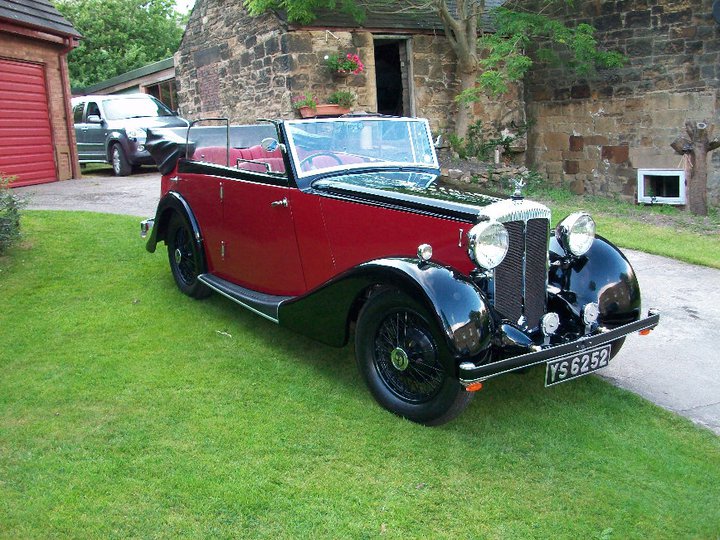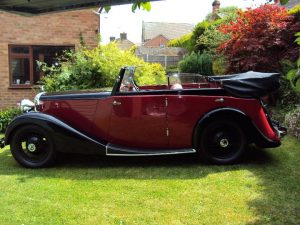
1936 Daimler Coupe
1936 Martin Walters Wingham Bodied
Daimler 15.
Registration: YS 6252
Date of first registration: 5th February 1936
Chassis Number: 41357
Engine Number: 77283
The car was originally owned by James Ferguson Whitton, Calder Glen, Lochwinnoch who owned a Tweed Mill and apparently supplied materials to Daimler.
I bought the car following an advertisement in the Driving Member from Mr David Peters of Aberdeen, Scotland in December 2009. The last entry in the log book shows June 1963, the car presumably laying derelict on farmland for the last 48 years.
David had bought the car in approximately 1999 in the condition as shown in the picture with the tarpaulin, with the intention of restoring. I never saw the car complete as the car had been stripped down by David. The car came to Wales on the back of my sons tipper truck (pictures show its arrival).
A deliriously frustrating yet rewarding labour of love lay ahead on its journey back to the road… but I had a vision.
Work on the restoration started at the beginning of 2010, the aim of the project being to have the car completed for the Daimler 2011 International Rally at Sandringham . As the months rolled by, my vision was fading and completion seemed almost impossible. Aside from chroming, the full restoration lay in my hands and a steep learning curve was required.
Needless to say, we made the Rally in 2011 with only hours to spare, the roof was completed on the Monday, carpets fitted on the Tuesday, she sailed through her MOT on Wednesday and we attended the show on the Sunday.
The Daimler Fifteen, was a saloon car announced in September 1932. It was the first Daimler product for more than two decades with an engine that breathed conventionally through poppet valves. Conventional valve gear had improved, superseding the former advantages of the Daimler-Knight sleeve-valve technology. The car’s name derived from its tax rating of 15 hp. The design of its 6-cylinder 1.8-litre engine was developed from the 4-cylinder 1.2-litre Lanchester Ten which was installed in Lanchester’s shorter versions of the same chassis and bodies and using the same Daimler semi-automatic transmissions.
| Daimler Fifteen 1932—1935 | |
|---|---|
 1936 Daimler Coupe |
|
| Overview | |
| Manufacturer | The Daimler Company Limited |
| Body and chassis | |
| Class | Executive car |
| Body style | four-door “six-light” saloon £450 Coupé £465 Chassis only £350—bodies as arranged with coachbuilder by customer |
| Layout | FR layout |
| Related | Lanchester Ten |
| Powertrain | |
| Engine | 1,805 cc 6-cylinder in-line ohv (at launch) 2,003 cc 6-cylinder in-line ohv (from August 1934) |
| Transmission | 4-speed Wilson preselective self-changing gearbox and Fluid Flywheel an open propellor shaft and underhung worm-driven axle |
| Dimensions | |
| Wheelbase | 109.5 in (2,780 mm) Track 50 in (1,300 mm) |
| Kerb weight | 24 cwt |
| Chronology | |
| Successor | Daimler Fifteen 1936 |
The Fifteen was the first Daimler to be offered at less than £500 since World War I. The Great Depression of the 1930s was well established and Daimler, responsible for economical BSA three-wheelers and, from 1931, the mid-price Lanchester range, went downmarket to assist sales in the austere times. Perhaps it took twenty years but this risky strategy with the Daimler name may have lost Daimler its super-luxury reputation and eventually brought about its demise.
In August 1934, in anticipation of the reduction in annual tax charge, the Fifteen was given a larger 2-litre engine. Again in August 1936 the engine was increased to 2.2-litres then another two years later to a full 2½-litres.
Engine
The long-stroke engine’s six cylinders and upper half of the crankcase are all in one block, like the detachable cylinder head, of cast-iron. The head carries the valves and rocker gear operated by pushrods from the chain-driven camshaft running in an oil bath within the block below. The pistons are of aluminium alloy. The crankshaft runs in four bearings and has a vibration damper.
Lubrication is fully forced including to the gudgeon pins. Cold starting conditions are provided for by splash lubrication to all vital parts. There are separate inlet and exhaust manifolds on the offside (left) with a hotspot. Cooling water circulates naturally to the radiator. A mechanical fuel pump delivers petrol from a tank at the back of the car.
Automatic engine starting is not needed as, owing to the fluid flywheel, the engine cannot be stalled in the ordinary way.
Transmission
The transmission consists of the Daimler fluid flywheel and its Wilson self-changing pre-selective, four-speed gearbox. An open propellor shaft takes the power to an underslung, worm-driven back axle.
The pre-selective finger-and-thumb lever for choosing gears is under the steering wheel and may be worked by the left hand.
Chassis
Engine, fluid flywheel and gearbox are assembled as one unit held at four points with rubber. The two back bearers are on the forward parts of the X-member of the chassis frame.
The springs are all semi-elliptic and are supplied with hydraulic shock absorbers. The springs are set wide to minimise any tendency to roll. On the radius-rod-controlled front axle they are shackled forwards, flat, splayed and held out of centre. The back springs are under the axle and outside the chassis frame.
Hydraulic four-wheel brakes by Lockheed are fitted with a vacuum servo. The frame passes below the rear springs to allow a low floor without wells within the foorboards.
The tyres on the 19 in (480 mm) wheels have a section of 4.75 in (121 mm)
[nivoslider id=”205″]

